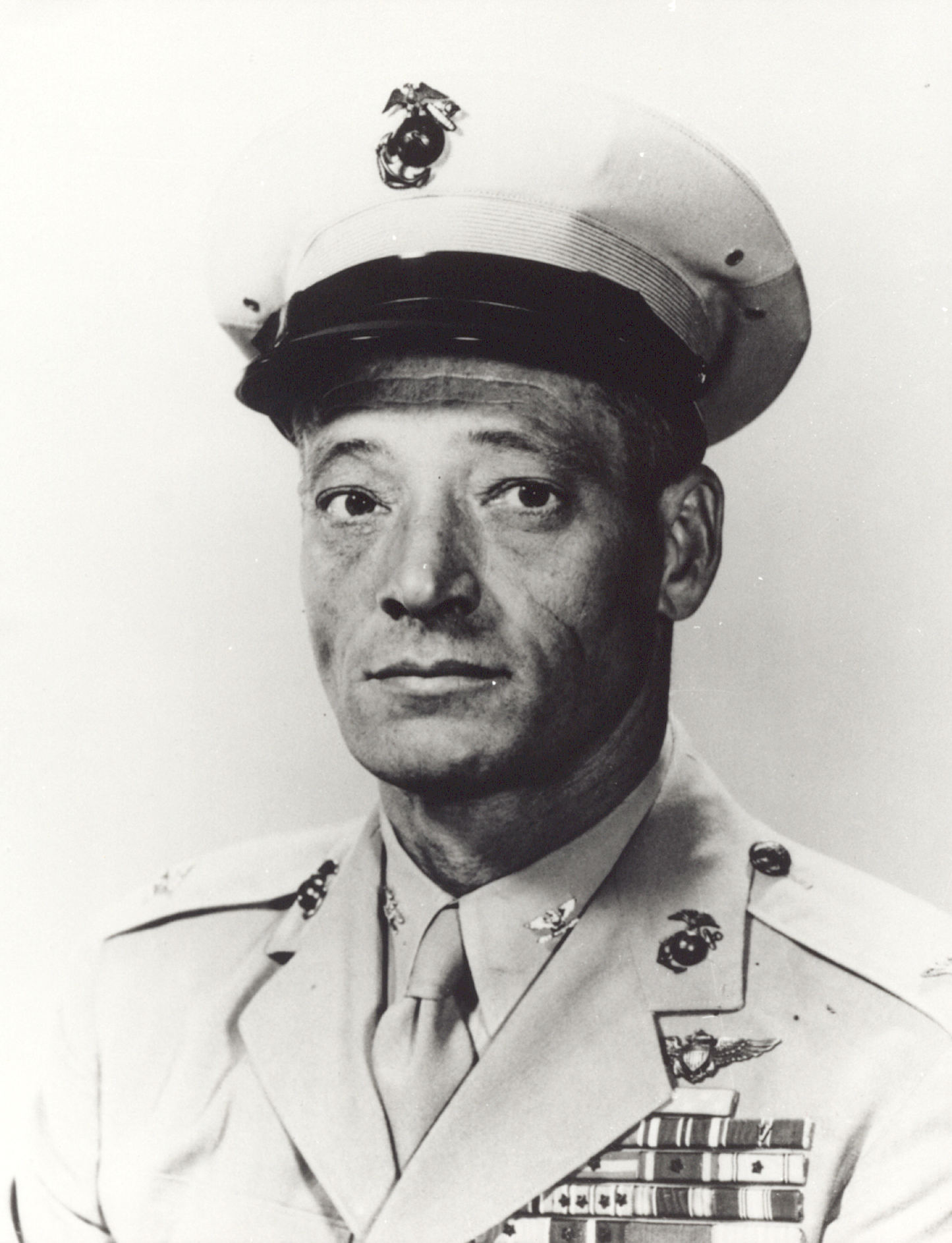
COLONEL
JOHN LUCIAN SMITH, USMC (DECEASED)
Medal of Honor Citation
John Lucian Smith, a Medal of Honor recipient and Marine Corps ace who shot down 19 Japanese planes in World War II, was born 26 December 1914 in Lexington, Oklahoma. He attended the University of Oklahoma where he was a member of the Reserve Officers Training Corps, graduating in May 1936. During the same month, he was appointed a second lieutenant in the Army Field Artillery, but resigned in July that year to accept a commission in the U.S. Marine Corps as a second lieutenant.
After receiving his Marine Corps commission, he was ordered to Marine Barracks, Navy Yard, Philadelphia, Pennsylvania, where he attended the Marine Basic School.
Following various duty assignments at Quantico, Virginia, Washington, D.C., and Parris Island, South Carolina, in 1937, he was transferred to the Naval Air Station, Pensacola, in July 1938, to begin flight training. A year later he graduated and was designated a Naval Aviator.
During the crucial battle for the Solomons, he led Marine Fighter Squadron 223 on sorties against the enemy, during which the squadron accounted for 83 enemy aircraft destroyed.
While on temporary duty in Washington after his return from the Pacific, he was awarded and presented the Medal of Honor by President Franklin D. Roosevelt on 24 February 1943.
After several months' duty in Washington, he shipped overseas again that fall to serve as Executive Officer of Marine Aircraft Group 32, then located at Oahu, Hawaii. A few months later, he moved to the Philippines and took part in the aerial offensives in the Bismarck Archipelago in November and December 1944; moved up to Luzon in the Philippines in January and February 1945; then on to Mindoro and Mindanao, and finally up to the Sulu Archipelago.
For his services in the Philippines during the period November 1944 to June 1945, he was awarded the Legion of Merit for exceedingly meritorious conduct in the performance of outstanding service as Executive Officer for Marine Aircraft Group 32 in extensive support of ground and surface forces in the liberation of Luzon, Zamboanga Peninsula, the Sulu Archipelago, and Mindanao.
After his return to the United States in June 1945, he served at the Naval Air Station, Jacksonville, Florida, until December 1945, and then was transferred to Quantico, Virginia, to serve as station operations officer. After his duty there and after performing various duties at Cherry Point, North Carolina, Washington, and Havana, Cuba, in 1946 and 1947, he was detached from duty at the Naval Air Station, Norfolk, Virginia, to perform duty involving flying on the staff of Commander, Air Force, Atlantic Fleet. In November 1948 he was on temporary aviation duty in England, France, and Germany.
Lieutenant Colonel Smith was detailed as Marine Corps Aide to the Chief of Naval Operations, Navy Department, Washington, in December 1949; promoted to colonel 1 January 1951; and in May 1951, he joined the Staff, Standing Group, of the North Atlantic Treaty Organization, for two years. Following duty with Marine Training Group 10, at the Marine Corps Air Station, El Toro, California, he began a year's duty in Korea, in July 1953. He served first as Commanding Officer, Marine Aircraft Group 33, until February 1954, then as Assistant Chief of Staff, G-4 of 1st Marine Aircraft Wing.
Upon his return from Korea, Col Smith was assigned to Headquarters Marine Corps in August 1954, and entered the National War College, completing the course in June 1955. The following month he was assigned to Marine Corps Schools, Quantico, as a member of the Advanced Research Group, serving in this capacity until July 1956. That August he assumed his duties at Pensacola Naval Air Station as Liaison Officer on the Staff of the Chief of Naval Air Training.
Colonel Smith died 10 June 1972 at Encino, California.
A complete list of Col Smith's medals and decorations includes: the Medal of Honor; the Legion of Merit with Combat "V;" the Distinguished Flying Cross; the Bronze Star Medal with Combat "V;" the Air Medal with three Gold Stars, indicative of four awards; the Presidential Unit Citation; the Navy Unit Commendation Ribbon with one bronze star; the American Defense Service Medal with Base clasp; the Asiatic-Pacific Campaign Medal with one silver star, indicative of five bronze stars; the American Campaign Medal; the World War II Victory Medal; the Navy Occupation Service Medal with European clasp; the National Defense Service Medal; the Korean Service Medal with one bronze star; the United Nations Service Medal; the Philippine Liberation Ribbon with one bronze star; the Philippine Presidential Unit Citation; and the Korean Presidential Unit Citation.
The colonel was also awarded Britain's Distinguished Service Order "for conspicuous gallantry and distinguished service…" in the Solomons.
World War II 1941-1945 Medal of Honor